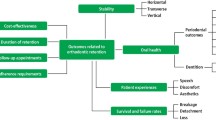Abstract
Design
This was a multicentre randomised controlled trial (RCT).
Intervention
Patients were treated in three centres and randomly allocated to one of three groups, as follows: group A used 0.016-inch nickel titanium (NiTi), 0.018×0.025-inch NiTi and 0.019×0.025-inch stainless steel (SS); group B used 0.016-inch NiTi, 0.016-inch SS, 0.020-inch SS and 0.019×0.025-inch SS; and group C used 0.016×0.022-inch copper-NiTi, 0.019×0.025-inch copper-NiTi and 0.019×0.025-inch SS.
Outcome measure
Outcome measures were patient discomfort at each archwire change and total discomfort for each archwire sequence, root resorption (root length) of an upper left central incisor (in mm), and time to reach an upper and lower working archwire (0.019×0.025-inch SS) in months, and also the number of visits.
Results
There were no statistically significant differences between archwire sequences A, B or C in terms of patient discomfort (P>0.05) or root resorption (P 0.58). The number of visits required to reach a working archwire was greater for sequence B than for A (P 0.012) but this could not be explained by the increased number of archwires used in sequence B.
Conclusions
The archwire sequences investigated were not statistically significantly different in terms of patient discomfort and upper incisor root resorption. However, clinicians may choose sequence A to minimise the number of visits required to attain a working archwire.
Similar content being viewed by others
Commentary
The objective of this RCT was to evaluate three orthodontic archwire sequences in terms of patient discomfort, root resorption, and time taken to achieve a working archwire. This is, in general, a well-designed and executed study. Only a couple of points warrant consideration.
For the sample size calculation, the authors considered a 3-month difference in the alignment and levelling phase to be a clinically significant difference in terms of efficiency. One can question whether, from a practice management point of view, the number of months saved is not as critical as the number of appointments saved. With current evolution of archwire technology the appointments have moved from conventional 3-week appointments to 8- to 10-week intervals between appointments. For a practice the real cost is clinical time or, put differently, how many times you have to see the patient — not how many months between appointments are expected. Therefore, an analysis considering the number of appointments required to attain the working wire would have been more directly clinically applicable.
Secondly, considering pre-existing root resorption only on the basis of upper left central incisor root apex has not been validated — although it may be a valid measure, in fact. In any event, it should not take too much longer to analyse the rest of the roots that appeared in the periapical x-ray and perhaps average the measurements. This would probably not have changed these findings significantly, however. Would a panoramic x-ray (pan) including the rest of the teeth make a difference? Probably not, especially if the root resorption diagnostic capability of a pan is taken into consideration.
Clinicians should consider the evidence presented and adapt it to their practices. It is not realistic to expect that such an RCT would present exactly the archwire sequence that individual clinicians would use and prefer in their practices. The archwire sequences selected do seem to represent fairly the commonly used sequences for 0.022 slot brackets, and therefore external validity is probably adequate for most clinical practices.
Practice point
Conventionally used levelling and alignment orthodontic archwires do not seem to produce significant discomfort and/or unacceptable iatrogenic root resorption in most circumstances.
If >2.5 mm is considered a clinically significant root-length loss, some patients do have significant root resorption from this initial stage of treatment (around 20%).
Author information
Authors and Affiliations
Additional information
Address for correspondence: Dr NA Mandall, School of Dentistry, University of Manchester, Higher Cambridge Street, Manchester M15 6FH, UK. E-mail: nicola.a.mandall@manchester.ac.uk
Mandall N, Lowe C, Worthington H, et al. Which orthodontic archwire sequence? A randomized clinical trial. Eur J Orthod 2006; 28:561–566
Rights and permissions
About this article
Cite this article
Flores-Mir, C. Attaining a working archwire – which sequence?. Evid Based Dent 8, 48 (2007). https://doi.org/10.1038/sj.ebd.6400494
Published:
Issue Date:
DOI: https://doi.org/10.1038/sj.ebd.6400494



